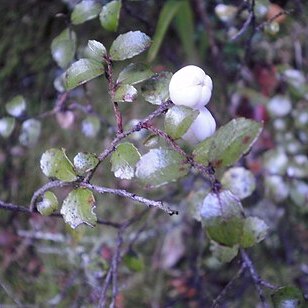Erect, ± spreading, up to c. 2 m. tall; branchlets densely to rather sparsely clad in long setose hairs and pubescence. Lvs on slender pubescent petioles up to c. 2 mm. long. Lamina coriac., glab or nearly so, (5)-7-10-(15) × (3)-6-10-(15) mm., suborbicular to broad-oblong to subovate, obtuse to subacute, apiculate; margins ± undulate, crenulate-denticulate to serrate; teeth minutely apiculate. Uppermost lvs sts so reduced that the infl. appears racemose. Fls solitary axillary, on pubescent bracteolate pedicels. Calyx deeply cut; lobes ovate-triangular, subacute to acute; corolla urceolate, lobes triangular, recurved. Fr. dry, surrounded by enlarged, ± fleshy, white to red or purplish calyx, up to c.10mm. diam.
A shrub. It can be low and spreading or upright. It grows about 30-200 cm high. The branches are covered with fine silvery hairs and brownish bristles. The leaves are oblong. They are 15 cm long. They are thick and leathery. The leaves are deep green. They have blunt teeth. The leaves are shiny and have very easy to see veins. The leaves often turn red in winter. The flowers are small and red or white. The fruit are white or sometimes red and 12 mm wide.

